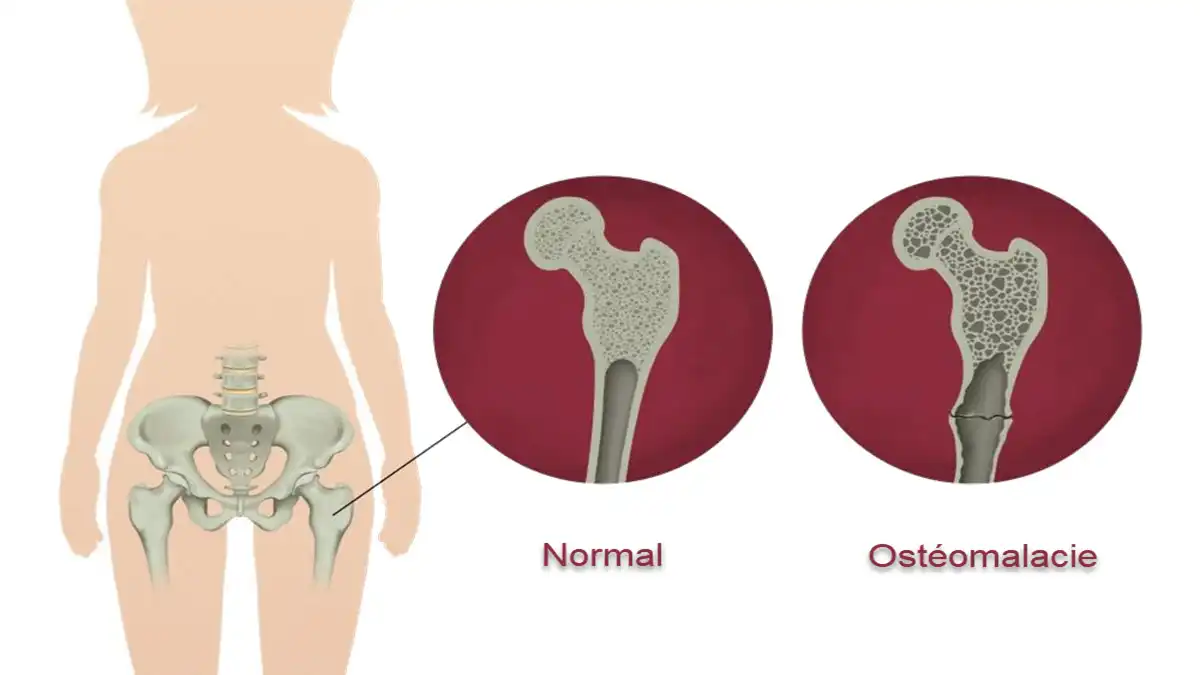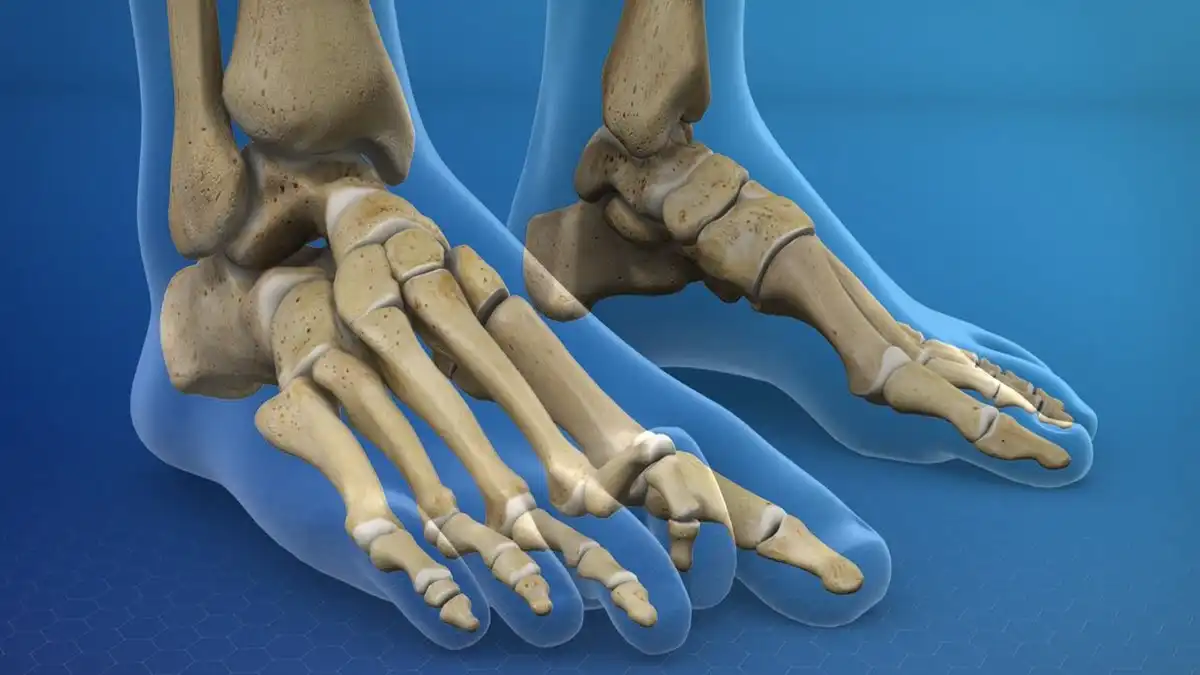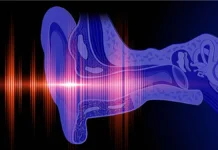Introduction
Osteoporosis, a condition characterized by increased bone fragility and susceptibility to fractures, poses a significant global health concern, impacting millions of individuals. While primary osteoporosis is commonly associated with natural aging and hormonal changes, secondary osteoporosis stems from diverse medical factors, medication use, or specific lifestyles. Comprehensive comprehension of the causes, risks, and management of secondary osteoporosis is crucial for both prevention and treatment.
Primary osteoporosis, often linked to aging, typically manifests post-menopause in women due to declining estrogen levels. In men, bone loss due to aging occurs later and to a lesser extent than in women. In contrast, secondary osteoporosis can emerge at any age and is frequently a consequence of specific medical conditions or lifestyle choices.
Various underlying medical conditions contribute to secondary osteoporosis. Endocrine diseases like hyperthyroidism or Cushing’s disease can disrupt hormonal balance, leading to bone loss. Similarly, gastrointestinal disorders such as celiac disease or inflammatory bowel disease can impact nutrient absorption crucial for bone health.
Certain medications are also associated with secondary osteoporosis. Long-term use of corticosteroids, commonly prescribed for inflammatory conditions, can result in significant bone loss. Additionally, certain cancer treatments, including chemotherapy and corticosteroids, may elevate the risk of osteoporosis.
Lifestyle choices play a pivotal role in secondary osteoporosis development. Established risk factors include smoking, excessive alcohol consumption, a diet low in calcium and vitamin D, and insufficient regular physical exercise.
Managing secondary osteoporosis often necessitates multifaceted treatment. Collaborating closely with medical professionals to tailor a treatment plan addressing the underlying condition is essential. This may involve correcting hormonal imbalances, adjusting medications, or managing associated medical conditions.
In addition to treating the root cause, general strategies are recommended to enhance overall bone health. These include maintaining a balanced diet rich in calcium, sufficient sunlight exposure for vitamin D synthesis, quitting smoking, limiting alcohol intake, and engaging in regular appropriate exercises, particularly those that strengthen bones.
Prevention of secondary osteoporosis assumes a critical role in preserving long-term bone health. This encompasses raising awareness of risk factors, undergoing regular health check-ups, and adopting healthy lifestyles. Individuals with specific risk factors, such as underlying medical conditions or the use of certain medications, should remain vigilant and consult their healthcare professionals regularly for tailored assessments and advice.
Causes of secondary osteoporosis
Unlike primary osteoporosis, secondary osteoporosis has identifiable causes contributing to bone density loss. Various medical conditions can lead to secondary osteoporosis, including endocrine disorders such as hyperthyroidism and Cushing’s syndrome. Gastrointestinal disorders such as celiac disease and inflammatory bowel disease can also impair the absorption of nutrients essential for bone health.
Certain medications play a significant role in the development of secondary osteoporosis. Prolonged use of glucocorticoids, commonly prescribed for conditions such as rheumatoid arthritis or asthma, can lead to bone loss. Additionally, treatments such as chemotherapy and hormone-related therapies can contribute to decreased bone density.
List of Causes
- Endocrine Diseases: Certain endocrine diseases, such as hyperthyroidism (excessive thyroid activity) and Cushing’s disease (excessive production of cortisol by the adrenal glands), can contribute to bone density loss.
- Digestive Disorders: Conditions such as celiac disease, inflammatory bowel disease (such as Crohn’s disease), and other digestive disorders can interfere with the proper absorption of calcium and other minerals essential for bone health .
- Renal Insufficiency: People with chronic kidney disease may have an imbalance in calcium and phosphorus metabolism, which can contribute to secondary osteoporosis.
- Medications: Certain medications can affect bone health by interfering with calcium metabolism. Long-term corticosteroids, medications used to treat certain inflammatory diseases, anticonvulsants, and treatments for excess thyroid may be associated with an increased risk of osteoporosis.
- Nutritional Deficiencies: Insufficient intake of calcium, vitamin D and other essential nutrients can contribute to bone fragility. Nutritional deficiencies may be linked to restrictive diets, eating disorders, or absorption problems.
- Hormonal Disorders: Certain medical conditions, such as primary or secondary amenorrhea in women, can lead to hormonal imbalance and contribute to bone loss.
- Physical Inactivity: A sedentary lifestyle or prolonged immobility, for example due to chronic illness or paralysis, can lead to decreased bone density.
- Alcoholism and Smoking: Excessive alcohol consumption and smoking are associated with an increased risk of osteoporosis. These habits can have detrimental effects on calcium metabolism and overall bone health.
- Metabolism Disorders: Certain metabolic conditions, such as hemochromatosis (excessive accumulation of iron in the body) or mucopolysaccharidosis (carbohydrate metabolism disorder), can influence bone density.
- Cancer: Certain types of cancers, particularly hematologic cancers (such as multiple myeloma) or bone tumors, can lead to secondary osteoporosis by affecting bone formation and resorption.
- Autoimmune Diseases: Autoimmune diseases such as systemic lupus erythematosus (SLE) and rheumatoid arthritis can lead to chronic inflammation, affecting bone health.
- Genetic Diseases: Certain rare genetic diseases, such as osteogenesis imperfecta (brittle bone disease) or juvenile idiopathic osteoporosis, can cause secondary osteoporosis.
- Gastric Surgery: Surgical procedures such as gastrectomy (partial or total removal of the stomach) can influence the absorption of nutrients, including calcium, thereby contributing to osteoporosis.
- Radiation therapy: Radiation therapy, often used in the treatment of cancer, can affect bone health by altering calcium metabolism and leading to bone loss.
- Hematologic Diseases: Certain hematologic disorders, such as thalassemia or sickle cell disease, may be associated with bone health problems due to disease-related complications.
- Malabsorptive Syndromes: Malabsorptive syndromes, such as short bowel syndrome or untreated celiac disease, can lead to insufficient absorption of essential nutrients, thereby affecting bone density.
- Use of Certain Medications: Certain medications, such as anticoagulants, anticonvulsants, aromatase inhibitors used to treat breast cancer, and long-term corticosteroids, may contribute to bone density loss.
- Hormonal Deficiencies: Hormonal disorders, such as a deficiency of sex hormones (estrogen and testosterone), can lead to decreased bone mass, as is often the case during menopause in women.
- Growth Treatment: Certain medical treatments for growth in children, such as prolonged use of corticosteroids, may influence bone development and contribute to secondary osteoporosis later in life.
- Hormonal Changes: Hormonal changes related to other medical conditions, such as hyperparathyroidism (overactivity of the parathyroid glands), may also play a role in deteriorating bone density.
Pathophysiology
Here is an overview of the pathophysiology of osteoporosis:
- Role of Bone Cells:
- Osteoblasts are cells responsible for bone formation. They synthesize bone matrix and promote mineralization.
- Osteoclasts are cells that break down and resorb bone matrix. The balance between osteoblast and osteoclast activity maintains bone density.
- Resorption/Formation Imbalance:
- In osteoporosis, there is an imbalance between bone resorption and bone formation.
- Bone resorption is often increased, while bone formation may be decreased.
- Decrease in Bone Mineral Density (BMD):
- Decreased bone formation and increased bone resorption lead to decreased bone mineral density (BMD).
- BMD is a measure of the amount of minerals in a certain amount of bone. Low BMD is characteristic of osteoporosis.
- Alterations of Bone Microarchitecture:
- In addition to the reduction in BMD, osteoporosis causes alterations in bone microarchitecture, making bones more vulnerable.
- Clinical Results:
- The combination of decreased bone density and alterations in microarchitecture increases the risk of fractures, particularly at the wrist, hip and vertebrae.
- Risk factors :
- Risk factors include age, sex (postmenopausal women are particularly vulnerable), family history of osteoporosis, low body mass, lack of physical activity, smoking, excessive alcohol consumption, and certain medical conditions and drug treatments.
- Secondary osteoporosis:
- In secondary osteoporosis, an underlying disease or medication use can directly affect bone metabolism, contributing to the decline in bone health.
- Hormonal Deficits:
- Hormonal changes, such as decreased estrogen levels in postmenopausal women, may also play a significant role in the pathophysiology of osteoporosis.
Risks and Predisposing Factors
Understanding the risk factors associated with secondary osteoporosis is essential for early identification and appropriate intervention. People with a family history of osteoporosis, especially secondary forms, may have a genetic predisposition. Lifestyle factors such as a sedentary lifestyle, smoking, excessive alcohol consumption and poor nutrition can also contribute to secondary osteoporosis.
Women experiencing early menopause due to surgical removal of the ovaries or certain medical treatments are at increased risk. Men with low testosterone levels, linked to aging or medical conditions, may also be susceptible. Those with a history of fractures or low body weight are more likely to develop secondary osteoporosis.
The risks and predisposing factors for osteoporosis can vary from person to person, but several elements are commonly associated with this condition. Understanding these factors is essential for identifying individuals at risk and implementing appropriate preventive measures. Some common risks and predisposing factors include:
List Risk and Factors
- Age: Aging is one of the main risk factors for osteoporosis. As individuals age, bone density tends to decrease, increasing the risk of fractures.
- Gender: Women are more likely to develop osteoporosis than men, especially after menopause. Declining estrogen levels in postmenopausal women contribute to accelerated bone loss.
- Family History: People with a family history of osteoporosis have an increased risk, suggesting a genetic component in predisposition to this disease.
- Body Composition: Low body mass is associated with an increased risk of osteoporosis. Thin people often have less bone reserves.
- Ethnicity: Certain ethnic groups, particularly people of Asian or Caucasian descent, are more predisposed to developing osteoporosis than others.
- Physical Activity Level: A sedentary lifestyle or lack of regular exercise can contribute to bone density loss.
- Diet: A diet low in calcium and vitamin D can affect bone health. Nutritional deficiencies can increase the risk of osteoporosis.
- Smoking: Smoking has been associated with decreased bone density, particularly in postmenopausal women.
- Alcohol Consumption: Excessive alcohol consumption can impair calcium absorption and increase the risk of osteoporosis.
- Hormone therapy: Certain medical treatments, such as prolonged use of corticosteroids, can negatively influence bone density
- Chronic Diseases: Certain chronic diseases, such as inflammatory bowel disease, kidney disease and diabetes, may be associated with an increased risk of osteoporosis.
- Medications: Certain medications, including corticosteroids, anticonvulsants, and aromatase inhibitors, may contribute to bone density loss.
- History of Fractures: Having previously suffered a fracture, especially after adulthood, can increase the risk of new osteoporosis-related fractures.
- Hormonal Deficits: Hormonal changes related to conditions such as hyperparathyroidism or prolonged amenorrhea can contribute to deterioration in bone density.
- Hormonal Disorders: Hormonal imbalances, such as insufficient thyroid production (hypothyroidism) or hyperthyroidism, can influence bone health.
- Chronic Respiratory Diseases: Certain chronic lung diseases, such as chronic obstructive pulmonary disease (COPD), may be linked to an increased risk of osteoporosis.
- Use of Certain Anti-Rejection Medications: People who have undergone an organ transplant and are taking immunosuppressive medications may be at increased risk of osteoporosis.
- High Cortisol Levels: High cortisol levels, whether due to Cushing’s disease or prolonged corticosteroid use, can contribute to bone density loss.
- Neurological Disorders: Certain neurological conditions, such as cerebral palsy or multiple sclerosis, may lead to an increased risk of osteoporosis due to reduced mobility.
- Genetic Changes: Genetic variations can influence individual predisposition to osteoporosis, although these genetic factors are often complex and multifactorial.
- Metabolic Disturbances: Metabolic disorders, such as metabolic syndrome or type 2 diabetes, may increase the risk of osteoporosis.
- Mobility Problems: People with mobility limitations, whether due to age, muscle disorders, or disabilities, may be more likely to develop osteoporosis.
- Menstrual Cycle Alterations: Menstrual cycle disturbances, including amenorrhea (absence of menstruation), may be associated with decreased bone density.
- Psychological Factors: Certain psychological disorders, such as anorexia nervosa, can lead to nutritional insufficiency and contribute to osteoporosis.
- Male Sex Hormone Deficiencies: In men, decreased testosterone levels can also contribute to bone loss.
- Repetitive Trauma: Activities or occupations involving repeated trauma, such as repeated impacts on the joints, can increase the risk of osteoporosis.
- History of Radiation Therapy: Previous radiation treatments, especially when targeted to bone, may contribute to loss of bone density.
- Growth Factor Deficiencies: Certain deficiencies in growth factors, which are essential for bone development, may be associated with an increased risk of osteoporosis.
- Rare Genetic Conditions: Some rare genetic conditions, such as pseudogliomatous osteoporosis, can lead to bone fragility.
- Psychiatric Disorders: Certain psychiatric disorders, such as severe depression, may be associated with behaviors and lifestyles that contribute to osteoporosis.
- Changes in Body Composition: Significant changes in body composition, such as extreme weight loss, can affect bone density.
- Impaired Intestinal Absorption: Chronic intestinal diseases, such as Crohn’s disease, can interfere with the proper absorption of nutrients necessary for bone health.
- Education Level and Economic Status: Lower education levels and poor socioeconomic status may be associated with less healthy lifestyle habits, potentially increasing the risk of osteoporosis.
- Ongoing Physical Stress: Ongoing physical stress, such as that related to prolonged hospitalization or immobilization, can contribute to bone density loss.
- Parathyroid Gland Dysfunction: Abnormalities of the parathyroid gland, such as secondary hyperparathyroidism, can lead to decreased bone density.
- Prolonged Use of Certain Medications: Certain medications, such as antipsychotics and some antiretroviral medications, may be associated with an increased risk of osteoporosis.
- Growth Hormone Deficiency: People with growth hormone deficiency, particularly in childhood, may have reduced bone mass and be more likely to develop osteoporosis as adults.
- Previous Treatment for Breast Cancer: Women who have undergone hormonal treatment, such as hormonal therapy for breast cancer, may be at increased risk of osteoporosis.
- Marfan syndrome: People with Marfan syndrome, a genetic disorder affecting connective tissue, may have reduced bone density.
- Use of Anti-Seizure Drugs: Some anti-seizure drugs, such as phenytoin and carbamazepine, may interfere with calcium metabolism and increase the risk of osteoporosis.
- Treatments for Thyroid Disease: Treatments for thyroid disease, such as prolonged use of antithyroid medications or thyroid removal, can influence bone health.
- Unexplained Genetic Factors: Research continues to explore other genetic factors that may be linked to osteoporosis predisposition.
- Systemic Autoimmune Diseases: Systemic autoimmune diseases, such as systemic lupus erythematosus (SLE) and scleroderma, can affect bone health due to systemic inflammation.
- Excessive Use of Caffeine: Excessive caffeine consumption can lead to loss of calcium in the urine, which can contribute to the breakdown of bone density.
- Use of Gastric Medications: Certain medications used to treat gastrointestinal problems, such as proton pump inhibitors, may be associated with an increased risk of osteoporosis.
- Rheumatoid Arthritis: Rheumatoid arthritis, a chronic inflammatory disease, can cause joint inflammation and contribute to bone density loss.
- Psychosocial Factors: Psychosocial stress, depression and anxiety can have implications on lifestyle, including diet and physical activity, thereby affecting bone health.
- Use of Immunomodulatory Medications: Some immunomodulatory medications used to treat conditions such as rheumatoid arthritis may influence bone density.
- Inherited Metabolic Disorders: Rare inherited metabolic disorders, such as juvenile idiopathic osteoporosis, can contribute to bone fragility at a young age.
- Chemotherapy History: Previous chemotherapy treatments, especially those used for certain types of cancer, can have side effects on bone health.
- Reproductive Disorders: Conditions such as amenorrhea (absence of menstruation) in women, often linked to eating disorders or hormonal imbalances, can contribute to loss of bone density.
- Prolonged Use of Antidepressants: Some antidepressants, particularly selective serotonin reuptake inhibitors (SSRIs), may be associated with an increased risk of osteoporosis.
- High Levels of Animal Protein in the Diet: Excessive consumption of animal protein, without balancing it with adequate amounts of fruits and vegetables, can affect acid-base balance and contribute to bone loss.
- Chronic Liver Diseases: Chronic liver diseases, such as cirrhosis, can impair nutrient metabolism and influence bone health.
- Turner syndrome: Women with Turner syndrome, a genetic condition linked to a partial or complete absence of the second sex chromosome, may have an increased risk of osteoporosis.
- Vitamin K Deficiency: A deficiency of vitamin K, which plays a role in regulating bone mineralization, may be associated with decreased bone density.
- Use of Antipsychotic Medications: Certain antipsychotic medications, particularly in older adults, may be linked to an increased risk of osteoporosis.
- Central Nervous System Disorders: Central nervous system disorders, such as spastic paralysis, can lead to reduced physical activity and contribute to bone loss.
- Changes in Microbiota Composition: Alterations in the composition of gut microbiota can affect nutrient absorption and have implications for bone health.
- Socio-Economic Factors: Adverse socio-economic conditions, such as lack of access to a balanced diet and adequate health care, can influence the prevalence of osteoporosis.
- Rapid Weight Changes: Rapid fluctuations in body weight, such as those seen during extreme diets, can impact bone density.
- Chronic Respiratory Diseases: Chronic respiratory diseases, such as severe asthma, may be associated with prolonged use of corticosteroid medications, increasing the risk of osteoporosis.
- Male Hypogonadism: Low testosterone levels in men, often linked to hypogonadism, can contribute to bone loss.
- Use of Anti-Retroviral Drugs: Some anti-retroviral drugs used to treat HIV may be associated with loss of bone density.
- Changes in Body Structure Due to Chronic Illnesses: Chronic illnesses causing changes in body structure, such as muscular dystrophy, can influence bone health.
- Changes in Dietary Fiber: A diet low in fiber can affect the absorption of minerals essential for bone health, thereby contributing to osteoporosis.
- Prolonged Sun Exposure: A lack of exposure to sunlight, necessary for the synthesis of vitamin D, can compromise bone health.
- Magnesium Deficiency: A deficiency of magnesium, an essential mineral for bone formation, may be associated with an increased risk of osteoporosis.
- Eating Disorders: Eating disorders, such as bulimia or anorexia, can lead to nutritional deficiencies affecting bone density.
- Use of Diuretic Medications: Certain diuretic medications, used to treat hypertension, may increase the elimination of calcium through the kidneys, contributing to bone loss.
- Exposure to Toxic Substances: Chronic exposure to toxic substances, such as certain heavy metals, can have negative effects on bone health.
- Vitamin B12 Deficiency: Vitamin B12 deficiency may be associated with an increased risk of osteoporosis, although the precise link requires more research.
- Chronic Stress: Chronic stress can trigger harmful hormonal responses, which can affect bone density.
- Use of Nonsteroidal Anti-Inflammatory Drugs (NSAIDs): Prolonged use of NSAIDs may be associated with loss of bone density, especially in older adults.
- Sleep Disorders: Sleep disorders, such as chronic insomnia, can have negative effects on bone health.
- Use of Anticonvulsant Medications: Some anticonvulsant medications may interfere with calcium metabolism, increasing the risk of osteoporosis.
- Physically Demanding Working Conditions: Physically demanding jobs, exposing the body to constant stress, can contribute to the deterioration of bone density.
- Use of Anticoagulant Medications: Certain anticoagulant medications may be associated with an increased risk of osteoporosis.
- Hormonal Changes Related to Pregnancy: Hormonal changes related to pregnancy and breastfeeding can temporarily influence bone density.
- Exposure to Environmental Radiation: Prolonged exposure to environmental radiation can have effects on bone health.
Management and Treatment
Effective management of secondary osteoporosis involves treating the underlying causes and implementing preventive measures. When a medical condition or medication contributes to bone loss, healthcare professionals may consider alternative treatments or adjust medication doses. For example, patients on prolonged glucocorticoid treatment may benefit from the lowest effective dose.
Lifestyle modifications play a crucial role in the management of secondary osteoporosis. Regular weight-bearing exercise, such as walking and weight training, promotes bone health. Adequate intake of calcium and vitamin D, either through diet or supplements, is essential for maintaining bone density.
For people at high risk of fractures, medications specifically designed to strengthen bones, such as bisphosphonates, may be prescribed. Hormone replacement therapy (HRT) may be considered in postmenopausal women to mitigate the effects of estrogen loss on bone density.
List of managements
- Treating the underlying cause: The first step is to identify and treat the underlying cause of secondary osteoporosis. These may include endocrine disorders (such as hyperthyroidism or hypogonadism), inflammatory diseases (such as rheumatoid arthritis), gastrointestinal diseases (such as Crohn’s disease), or the use of certain medications.
- Calcium and vitamin D supplementation: These elements are essential for bone health. Adequate intake of calcium and vitamin D can help strengthen bones and prevent loss of bone density.
- Drug treatment: Certain medications may be prescribed to improve bone density and reduce the risk of fractures. Bisphosphonates, RANK ligand inhibitors, selective estrogen receptor modulators, and other medications may be considered depending on the specific clinical situation.
- Physical exercise: Regular exercise, especially activities that involve body weight and resistance, can strengthen bones. Strength training exercises and moderate impact activities are often recommended.
- Lifestyle modifications: Lifestyle modifications, such as quitting smoking and limiting alcohol consumption, can help improve bone health.
- Regular monitoring: Regular monitoring with bone mineral density tests and other clinical assessments is essential to evaluate the effectiveness of treatment and make adjustments if necessary.
- Fall prevention: Since people with osteoporosis have an increased risk of fractures, fall prevention is crucial. This may include interventions such as improving balance, modifying the environment to reduce fall risk, and possibly using walking aids if necessary.
- Appropriate nutrition: Ensure the patient receives a balanced diet rich in essential nutrients for bone health. Besides calcium and vitamin D, other nutrients such as vitamin K, magnesium, and phosphorus may also play a role in bone health.
- Patient education: Inform the patient about their condition, risk factors and preventive measures. Education may also include lifestyle advice, such as the importance of a balanced diet, regular exercise, and avoiding tobacco and excess alcohol.
- Hormonal therapy: In some cases, especially in postmenopausal women, hormonal therapy may be considered. However, the risks and benefits of this approach must be carefully evaluated.
- Bone mineral density (BMD) assessment: Bone mineral density tests, such as bone densitometry, are essential for assessing bone health and monitoring the effectiveness of treatment.
- Treatment of fracture-related pain: In cases of osteoporosis-related fractures, pain relief and management of associated complications are important to improve the patient’s quality of life.
- Regular monitoring of hormonal levels: For underlying endocrine conditions, regular monitoring of hormonal levels is necessary to adjust treatment accordingly.
- Management of comorbidities: Patients with secondary osteoporosis may also have other health problems. Comprehensive management of comorbidities is necessary to optimize the patient’s general health.
- Continuing Research: Given the constant evolution of medical knowledge, it is important to stay informed of advances in the field of osteoporosis and adapt treatment protocols accordingly.
- Bone quality assessment: In addition to bone mineral density, bone quality assessment can be performed. Techniques such as magnetic resonance imaging (MRI) tomography can help assess bone microarchitecture and identify aspects that are not necessarily reflected by bone mineral density alone.
- Physical therapy: Physical therapy programs may be recommended to improve muscle strength, balance and posture, helping to reduce the risk of falls and fractures.
- Targeted Pharmacotherapy: Depending on the underlying cause, specific medications may be used to treat the initial condition, helping to lessen the impact on bone health.
- Assessment of genetic factors: In some cases, it may be useful to assess genetic factors that could influence predisposition to osteoporosis. This can help further personalize the treatment plan.
- Complementary therapies: Certain complementary therapies, such as acupuncture, physiotherapy, or specific supplements (such as collagen or certain amino acids), may be explored in addition to conventional treatment. However, it is important to discuss these options with a healthcare professional.
- Continuing Education Program: Patients should be encouraged to participate in continuing education programs about osteoporosis, which can help them understand and proactively manage their condition.
- Periodic Reassessment: Treatment plans and interventions should be reevaluated regularly based on the patient’s evolving condition, test results, and any changes in their overall health.
- Psychological support: People with osteoporosis may experience anxiety or depression related to their condition. Psychological support, such as seeing a psychologist or a support group, may be beneficial.
Prevention Strategies
Prevention of secondary osteoporosis requires a multidimensional approach. Encouraging a healthy lifestyle, including a balanced diet and regular physical activity, is fundamental. Early identification and treatment of underlying medical conditions can prevent further bone loss.
Regular bone density assessments, especially for people at high risk, allow for early detection of osteoporosis. This allows rapid intervention and reduces the risk of fractures. Healthcare professionals should educate patients about the importance of bone health and the potential impact of certain medications or medical conditions on bone density.
In conclusion, secondary osteoporosis presents unique challenges due to its association with specific medical conditions, medications, or lifestyle factors. Recognizing the causes, identifying risk factors and implementing appropriate management strategies are essential to preventing bone loss and reducing the risk of fractures. A comprehensive approach, involving healthcare professionals, patients and preventative measures, is the key to effectively addressing the complexities of secondary osteoporosis.
List of prevention strategies
- Adequate intake of calcium and vitamin D: These nutrients are essential for bone health. Foods rich in calcium include dairy products, green leafy vegetables, nuts and fish. Sun exposure is a natural source of vitamin D, and it can also be obtained from certain foods and supplements.
- Balanced diet: Adopting a balanced diet, rich in fruits, vegetables, whole grains, lean proteins and dairy products, helps provide the nutrients necessary for bone health.
- Regular exercise: Regular physical activity, especially bodyweight and resistance exercises, helps strengthen muscles and bones. Moderate-impact activities, such as walking, running or dancing, are particularly beneficial.
- Avoid smoking: Smoking is associated with decreased bone mineral density. Avoiding tobacco can therefore help maintain bone health.
- Limit alcohol consumption: Excessive alcohol consumption can have a negative impact on bone health. It is recommended to limit alcohol consumption in accordance with health guidelines.
- Maintain a healthy body weight: Adequate body weight helps reduce the load on bones and can help prevent loss of bone density.
- Avoid falls: Falls represent a major risk of fractures, especially in people with osteoporosis. Preventative measures such as removing obstacles in the home, using appropriate footwear, and practicing balance exercises can help prevent falls.
- Medical Monitoring: People with high risk factors for osteoporosis should see their doctor for regular assessment of bone health. This may include bone mineral density testing and other clinical assessments.
- Early treatment of underlying disorders: If an underlying disease is identified as the cause of secondary osteoporosis, early treatment of this condition can help minimize the impact on bone health.
- Continuing education: Public education campaigns about osteoporosis and its risk factors can raise awareness and encourage preventive behaviors.
- Adequate intake of calcium and vitamin D: These nutrients are essential for bone health. Foods rich in calcium include dairy products, green leafy vegetables, nuts and fish. Sun exposure is a natural source of vitamin D, and it can also be obtained from certain foods and supplements.
- Balanced diet: Adopting a balanced diet, rich in fruits, vegetables, whole grains, lean proteins and dairy products, helps provide the nutrients necessary for bone health.
- Regular exercise: Regular physical activity, especially bodyweight and resistance exercises, helps strengthen muscles and bones. Moderate-impact activities, such as walking, running or dancing, are particularly beneficial.
- Avoid smoking: Smoking is associated with decreased bone mineral density. Avoiding tobacco can therefore help maintain bone health.
- Limit alcohol consumption: Excessive alcohol consumption can have a negative impact on bone health. It is recommended to limit alcohol consumption in accordance with health guidelines.
- Maintain a healthy body weight: Adequate body weight helps reduce the load on bones and can help prevent loss of bone density.
- Avoid falls: Falls represent a major risk of fractures, especially in people with osteoporosis. Preventative measures such as removing obstacles in the home, using appropriate footwear, and practicing balance exercises can help prevent falls.
- Medical Monitoring: People with high risk factors for osteoporosis should see their doctor for regular assessment of bone health. This may include bone mineral density testing and other clinical assessments.
- Early treatment of underlying disorders: If an underlying disease is identified as the cause of secondary osteoporosis, early treatment of this condition can help minimize the impact on bone health.
- Continuing education: Public education campaigns about osteoporosis and its risk factors can raise awareness and encourage preventive behaviors.
Differential Diagnostics
List of differential diagnosis
- Osteomalacia: This is a disease characterized by bone demineralization due to a lack of mineralization of the bone matrix. Unlike osteoporosis, where bone mineral density is reduced, in osteomalacia the mineral composition of the bones is normal, but the bone matrix is poorly mineralized.
- Multiple Myeloma: This form of cancer affects plasma cells in the bone marrow, which can lead to bone damage and loss of mineral density. Frequent bone fractures and the presence of abnormal proteins in the blood (monoclonal proteins) can distinguish multiple myeloma from osteoporosis.
- Primary Hyperparathyroidism: This condition is characterized by excessive secretion of parathyroid hormone, which can lead to excessive bone resorption and demineralization. High serum calcium levels and hyperparathyroidism are indicators of this condition.
- Inflammatory Diseases of the Skeletal System: Diseases such as rheumatoid arthritis and systemic lupus erythematosus can affect the joints and, in some cases, lead to decreased bone density.
- Hyperthyroidism: Excess thyroid hormones can increase bone resorption, leading to loss of bone density.
- Cushing’s syndrome: Excess cortisol, often associated with Cushing’s syndrome, can lead to decreased bone mineral density.
- Gastrointestinal Disorders: Disorders such as celiac disease or Crohn’s disease can affect the absorption of nutrients essential for bone health, which can lead to loss of bone density.
- Genetic Diseases: Certain genetic diseases, such as osteogenesis imperfecta, can lead to bone fragility. However, these conditions are often diagnosed at a young age.
- Anorexia Nervosa Syndromes: Eating disorders such as anorexia nervosa can lead to decreased bone density due to malnutrition and amenorrhea.
- Deforming Osteopathy (Paget): Also called Paget’s disease, it is characterized by abnormal bone growth which can lead to bone fragility. This can sometimes be confused with osteoporosis.
- Hypogonadism: Low levels of sex hormones, whether in men (male hypogonadism) or women (female hypogonadism), can contribute to decreased bone density.
- Chronic Renal Failure: Patients with chronic renal failure may develop renal osteodystrophy, characterized by alterations in bone density.
- Hemochromatosis: Excess iron in the body (hemochromatosis) can affect bone health.
- Hematological Diseases: Certain blood diseases, such as thalassemia, may be associated with loss of bone density.
- Histiocytosis X: A rare condition where immune system cells called histiocytes build up in various organs, including bones.
- Hypophosphatasia: A rare genetic disorder characterized by decreased levels of an enzyme called alkaline phosphatase, leading to defects in bone mineralization.
- Neurological Diseases: Certain neurological conditions, such as paraplegia, can lead to decreased bone density due to loss of use of limbs.
- Sarcoidosis: A systemic inflammatory disease that can affect organs, including bones.
- Metabolic Diseases: Metabolic disorders such as diabetes can influence bone health.
- Medication Side Effects: Some medications, such as long-term corticosteroids, can cause loss of bone density.
- Autoimmune Diseases: Some autoimmune diseases, such as systemic lupus, can affect the joints and bones, leading to loss of bone density.
- Psoriatic Arthritis: This form of inflammatory arthritis that affects people with psoriasis may also be associated with changes in bone density.
- Congenital Anomalies: Certain congenital bone anomalies may present with characteristics similar to those of osteoporosis.
- Leukemia: Some types of leukemia can invade the bone marrow, affecting normal bone formation.
- Marfan Syndrome: A genetic disorder that can affect connective tissue, including bone tissue.
- Hypercalcemia: Excess calcium in the blood can lead to loss of bone density. This may be associated with conditions such as hyperparathyroidism, certain tumors, or kidney problems.
- Osteogenesis Imperfecta (OI): Also called “brittle bone disease,” OI is a genetic disease characterized by increased bone fragility.
- Multiple Sclerosis: Some people with multiple sclerosis may be more prone to fractures due to a combination of low bone density and increased risk of falling.
- Chronic Lung Diseases: Certain chronic lung diseases, such as chronic obstructive pulmonary disease (COPD), can influence bone health.
- Turner syndrome: A genetic abnormality that can affect women, sometimes leading to loss of bone density.
- Wilson’s disease: A rare genetic disorder that causes a buildup of copper in the body, affecting various organs, including the bones.
- Hemophilia: A blood clotting disorder that may be associated with internal bleeding, which can impact bone health.
- Amyloidosis: A disease characterized by the abnormal deposition of proteins in tissues, including bones.
- Inflammatory Myopathies: Certain inflammatory muscle disorders can influence mobility and the load exerted on the bones.
- Vitamin C Deficiency (Scurvy): Severe vitamin C deficiency can lead to bone problems and increased fragility.
- Muscular Dystrophy: Certain types of muscular dystrophy can affect bone health due to a reduction in physical activity.
- Neurofibromatosis Type I (von Recklinghausen disease): A genetic disease that can affect bone tissue.
- Ehlers-Danlos Syndrome: A group of genetic disorders that affect collagen production, which can influence bone structure.
- Ankylosing Spondylitis: A form of inflammatory arthritis that can affect the spine and sacroiliac joints.
- Pituitary Insufficiency: Dysfunction of the pituitary gland can affect the levels of growth hormones, which play a role in bone health.
- Familial Hypophosphatemia: An inherited condition characterized by a low concentration of phosphate in the blood.
- Lipodystrophy: A group of genetic disorders characterized by a loss of fatty tissue, which can influence metabolism and bone health.
- Fluoride Deficiency: In some cases, a deficiency or excess of fluoride can affect bone health.
- Lymphoma: Some lymphomas can invade the bones and influence bone density.
- Rickets: A disease characterized by bone deformation due to a lack of mineralization, often associated with a vitamin D deficiency.
- Hypertrophic Osteopathy (Osteitis Deformans): A condition characterized by excessive growth of bone, resulting in deformities.
Conclusion
In conclusion, secondary osteoporosis represents a complex and multifaceted condition, often arising from underlying factors such as diseases or medical treatments that directly impact bone metabolism. The effective management of secondary osteoporosis requires a nuanced and targeted approach, addressing not only the symptomatic bone loss but also the root cause.
Understanding the pathophysiology of secondary osteoporosis is crucial, as it is intricately linked to the specific disease or medical situation responsible. Conditions like rheumatoid arthritis, inflammatory bowel disease, hypogonadism, or prolonged use of certain medications can lead to a decline in bone density. Therefore, a thorough evaluation of medical history, clinical examinations, and diagnostic investigations is essential for accurate diagnosis and tailored treatment.
Prevention of secondary osteoporosis involves proactive management of related diseases or medical conditions. This may include appropriate drug treatments, necessary surgical interventions, and the promotion of a healthy lifestyle customized to the patient’s specific situation.
Collaboration among healthcare professionals, including rheumatologists, endocrinologists, and other specialists, is indispensable for comprehensive care. Equally important is patient education, providing individuals with a deeper understanding of the nature of secondary osteoporosis, its associated risk factors, and effective prevention strategies. This knowledge empowers patients to actively participate in their healthcare journey, promoting proactive management and an improved quality of life.
In summary, managing secondary osteoporosis requires a holistic, multidisciplinary approach that considers both the underlying cause and its implications for bone health. Early intervention, accurate diagnosis, and preventative measures emerge as critical elements in achieving effective and comprehensive management of this specific form of osteoporosis.
References
- Ensrud KE, Crandall CJ. Osteoporosis . Ann Intern Med. 2017 Aug 01;167(3):ITC17-ITC32. [ PubMed ]2.
- Ebeling PR, Nguyen HH, Aleksova J, Vincent AJ, Wong P, Milat F. Secondary Osteoporosis . Endocr Rev. 2022 Mar 09;43(2):240-313. [ PubMed ]3.
- Kanis JA, Harvey NC, Liu E, Vandenput L, Lorentzon M, McCloskey EV, Bouillon R, Abrahamsen B, Rejnmark L, Johansson H., Danish Primary Hyperparathyroidism Study Group. Primary hyperparathyroidism and fracture probability. Osteoporos Int. 2023 Mar;34(3):489-499. [ PubMed ]4.
- Yano C, Yokomoto-Umakoshi M, Fujita M, Umakoshi H, Yano S, Iwahashi N, Katsuhara S, Kaneko H, Ogata M, Fukumoto T, Terada E, Matsuda Y, Sakamoto R, Ogawa Y. Coexistence of bone and vascular disturbances in patients with endogenous glucocorticoid excess. Bone Rep. 2022 Dec;17:101610. [ PMC free article ] [ PubMed ]5.
- Delitala AP, Scuteri A, Doria C. Thyroid Hormone Diseases and Osteoporosis . J Clin Med. 2020 Apr 06;9(4) [ PMC free article ] [ PubMed ]6.
- Gravholt CH, Viuff MH, Brun S, Stochholm K, Andersen NH. Turner syndrome: mechanisms and management. Nat Rev Endocrinol. 2019 Oct;15(10):601-614. [ PubMed ]7.
- Golds G, Houdek D, Arnason T. Male Hypogonadism and Osteoporosis : The Effects, Clinical Consequences, and Treatment of Testosterone Deficiency in Bone Health. Int J Endocrinol. 2017;2017:4602129. [ PMC free article ] [ PubMed ]8.
- Ala M, Jafari RM, Dehpour AR. Diabetes Mellitus and Osteoporosis Correlation: Challenges and Hopes. Curr Diabetes Rev. 2020;16(9):984-1001. [ PubMed ]9.
- Hidayat K, Du X, Wu MJ, Shi BM. The use of metformin, insulin, sulphonylureas, and thiazolidinediones and the risk of fracture: Systematic review and meta-analysis of observational studies. Obes Rev. 2019 Oct;20(10):1494-1503. [ PubMed ]10.
- Yang BR, Cha SH, Lee KE, Kim JW, Lee J, Shin KH. Effect of dipeptidyl peptidase IV inhibitors, thiazolidinedione, and sulfonylurea on osteoporosis in patients with type 2 diabetes: population-based cohort study. Osteoporos Int. 2021 Sep;32(9):1705-1712. [ PubMed ]11.
- Wysham KD, Baker JF, Shoback DM. Osteoporosis and fractures in rheumatoid arthritis. Curr Opin Rheumatol. 2021 May 01;33(3):270-276. [ PubMed ]12.
- Chedevergne F, Sermet-Gaudelus I. Prevention of osteoporosis in cystic fibrosis. Curr Opin Pulm Med. 2019 Nov;25(6):660-665. [ PubMed ]13.
- Chen YW, Ramsook AH, Coxson HO, Bon J, Reid WD. Prevalence and Risk Factors for Osteoporosis in Individuals With COPD: A Systematic Review and Meta-analysis. Chest. 2019 Dec;156(6):1092-1110. [ PubMed ]14.
- Bover J, Ureña-Torres P, Laiz Alonso AM, Torregrosa JV, Rodríguez-García M, Castro-Alonso C, Górriz JL, Benito S, López-Báez V, Lloret Cora MJ, Cigarrán S, DaSilva I, Sánchez-Bayá M , Mateu Escudero S, Guirado L, Cannata-Andía J. Osteoporosis , bone mineral density and CKD-MBD (II): Therapeutic implications. Nefrologia (Engl Ed). 2019 May-Jun;39(3):227-242. [ PubMed ]15.
- Ryan LE, Eng SW. Idiopathic hypercalciuria: Can we prevent stones and protect bones? Cleve Clin J Med. 2018 Jan;85(1):47-54. [ PubMed ]16.
- Hurley T, Zareen Z, Stewart P, McDonnell C, McDonald D, Molloy E. Bisphosphonate use in children with cerebral palsy. Cochrane Database Syst Rev. 2021 Jul 05;7(7):CD012756. [ PMC free article ] [ PubMed ]17.
- Marreiros H. Update on bone fragility in spina bifida. J Pediatr Rehabil Med. 2018;11(4):265-281. [ PubMed ]18.
- Ward LM, Hadjiyannakis S, McMillan HJ, Noritz G, Weber DR. Bone Health and Osteoporosis Management of the Patient With Duchenne Muscular Dystrophy. Pediatrics. 2018 Oct;142(Suppl 2):S34-S42. [ PMC free article ] [ PubMed ]19.
- Gupta S, Ahsan I, Mahfooz N, Abdelhamid N, Ramanathan M, Weinstock-Guttman B. Osteoporosis and multiple sclerosis: risk factors, pathophysiology, and therapeutic interventions. CNS Drugs. 2014 Aug;28(8):731-42. [ PubMed ]20.
- Figueroa CA, Rosen CJ. Parkinson’s disease and osteoporosis : basic and clinical implications. Expert Rev Endocrinol Metab. 2020 May;15(3):185-193. [ PMC free article ] [ PubMed ]





















